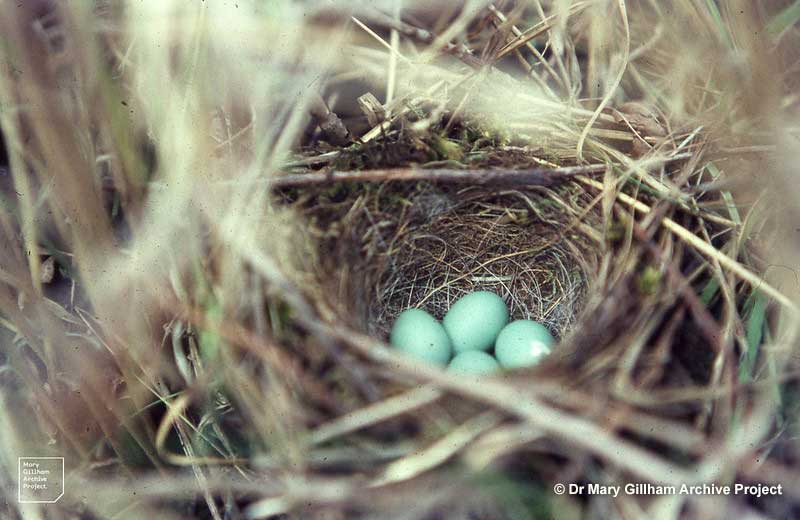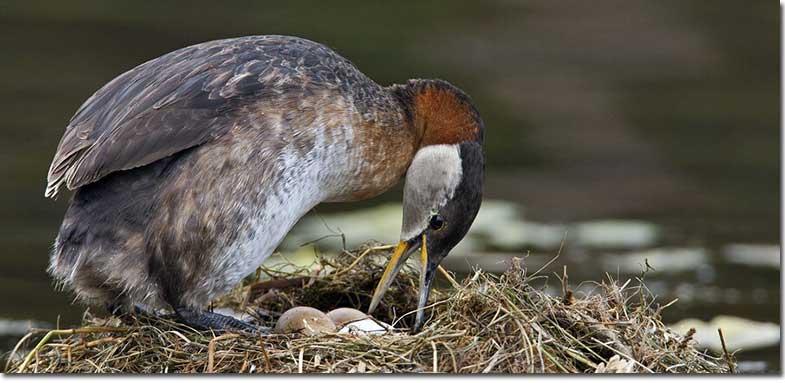
Which came first – the chicken or the egg? We can debate, but one thing is certain—all birds came into this world by hatching from an egg.
Still, have you ever wondered how egg incubation and hatching actually work? How long does it last, and what happens under that shell while parent birds lie on the eggs?
Read on to learn all about egg incubation and hatching in birds!
On this page
Why Eggs Exist?
Basically, an egg is a fully-equipped “self-contained life-support system” for the embryo. It provides food, protection, and respiration (oxygen in, carbon dioxide out) for the growing baby bird.
Reptiles were the first to “patent” the terrestrial egg, but birds perfected the design.
Bird eggs have thick shells and a fatty yolk, which creates metabolic water for the embryo while it dissolves.
For their eggs to hatch successfully, birds must keep them warm and sheltered using their own bodies. That process is called incubation.
What Happens During Incubation?
By actively incubating their eggs, birds ensure optimal temperature and humidity for the development of their babies. Eggshells are already well-suited to maintain temperature and moisture, but they need some extra TLC from the parents.
Here is how the egg incubation process in birds goes down step by step.
Egg-laying

After the nest is complete, it’s time for egg-laying. Most incubating birds lose feathers on the abdomen, creating a bald spot called a brood patch or incubation patch. Plumage acts as insulation, so the parent bird needs to lose some of it in a strategic place (the belly) to be able to transfer its body heat to the eggs.
Related: Types of nests & how to see who they belong to
The brood patch placement and size vary by species. Some seabirds and waterbirds like boobies, gannets, pelicans, and penguins don’t acquire patches. Instead, they use the top of their feet to ensure skin-to-shell contact. Cowbirds and cuckoos do not incubate their eggs at all, so they don’t ever get a brood patch.
The clutch size highly depends on the species. In birds with more than one egg per clutch, the female usually lays one egg daily.
Incubation
The bird, usually a female, will start incubating the egg as soon as the clutch is complete. When settling down to incubate, the incubating parent will make a characteristic side-to-side motion to “tuck in” the eggs and ensure the best possible contact of the brood patch with the egg surface.
The incubation time depends on the species – it can range anywhere from 10 days to 2.5 months. In general, the bigger the bird species, the longer the incubation time. Chickens and most other domesticated fowl hatch their eggs within 21-28 days.

Red-necked Grebe at nest
In the majority of species, both parents incubate the eggs, taking turns at the nest; however, there are exceptions. In fowl, waterfowl, and gamebirds, the female incubates the eggs while the male (if present) guards the nest.
Most birds turn the eggs regularly to ensure they are warmed (incubated) equally on all sides, ensuring even embryonic development.
Hatching
Since the shell is hard, chicks need tools to open their way to the outside world. That is why they have an egg tooth.
The egg tooth is a transient sharp cap at the tip of the chick’s beak. It has only one purpose – to break the eggshell. After hatching, it disappears.
Breaking out of an egg sort of looks like an action movie scene where the main protagonist has to break a narrow window and squeeze himself out of trouble. The hatchling pecks a hole in the shell using its egg tooth, then rests a while. Then, it goes on to peck a circle around one end of the egg.
In the final stage, the hatchling twists its neck and pushes with its feet, finally breaking the shell. After this, a new stage begins – growing stronger until they leave the nest and learn their ways.
Incubating Domestic Birds
To fully control the process and increase the hatching rate, bird farmers and breeders rarely let the mother bird incubate the egg clutch. Instead, they take the eggs out of the nest and put them in an incubator.
An incubator is a device equipped with a thermostat that holds the eggs and incubates them at the right temperature.
In general, bird eggs are artificially incubated at a temperature between 99.5 and 100.0°F (37.5-37.8 C).
The only exceptions for farm birds are emu and ostrich, requiring slightly lower incubation temperatures – 95.5 – 96.5°F (35.3 – 35.8°C) and 97.0 to 98.0°F (36.1 – 36.6°C), respectively.
However, setting the right temperature is not the end of it – you must turn the eggs every hour or at least five times in 24 hours to ensure equal development. Incubated eggs that don’t get turned will not hatch. Automatic incubators turn the eggs as programmed.
If you found an abandoned bird egg (and you are 100% certain it’s abandoned), you can try incubating it, even if the egg hasn’t been warmed for a while. However, knowing that raising wild bird chicks is challenging is best left to professional wildlife rehabilitators.
The Shortest And Longest Hatchers & Other Fun Facts
- The record holders for the shortest incubation time are the White-eye and Cowbird – it takes only 10-12 days for their eggs to hatch.
- The longest incubation time award goes to Wandering Albatross. Both parents take turns incubating a single egg for 11 whole weeks!
- The largest egg parent is the Ostrich; average ostrich eggs measure 6×5 inches (15×13 cm) and weigh 3 pounds (1.5 kg).
- Vervain Hummingbird from Jamaica lays the officially tiniest bird eggs. The smallest egg specimen measured less than 10 mm (0.39 in) in length and weighed only 0.0128 oz.
- The largest egg in relation to body size is laid by New Zealand Kiwi birds, particularly the North Island Brown Kiwi. The egg weighs 15 to 22 percent of the female’s weight. In comparison, imagine if an average 170 lbs. woman gave birth to a 34-pound baby!
- While incubating his egg, the stay-at-nest dad Emperor Penguin loses around one-third of his body weight (he can’t feed while incubating the egg on his feet in his egg pouch).
- Cuckoos, Cowbirds, and Honeyguides do not incubate their eggs. They are brood parasites, laying their eggs in the host bird’s nest. The “adoptive” parents will take full care of the parasitic chick, and their own chicks – the “adoptive siblings” – will likely get pushed out of the nest.
- Both bird and reptile eggshells are made of calcium carbonate (CaCO3) in the form of calcite; the only exceptions are turtles, whose shells are built of aragonite (CaCO3 + magnesium).
- Eggs are not hermetically closed. The eggshells have pores that allow the embryo to breathe – the oxygen goes in, and carbon dioxide goes out.
You Might Also Ask
How does egg incubation work?
Because bird embryos develop outside of the mother’s body, the parent birds (or humans) need to control the temperature and other factors externally. Incubation is a process that ensures the right temperature, humidity, and even development through egg turning. If all the parameters are within a desirable range, the egg embryo will grow harmoniously, resulting in chick hatching at the end of the incubation period.
Do birds incubate their eggs continuously?
Surprisingly, no. Birds don’t start incubating until they lay all of the eggs, and laying can span days. If a Mallard lays one egg per day, she will need at least 12 days to complete the entire clutch. If she started incubating momentarily, there would be a significant disparity in the developmental stages of her chicks, making them harder to take care of.
Delaying incubation ensures that all embryos start developing at the same time.
Similarly, at certain times, birds will spend less time incubating to control the pace of the embryo development inside. So, if you see a nest where both parents are absent for hours, don’t worry about the eggs – mom and dad know what they’re doing.
How long can hatching eggs go without heat?
Eggs that have not started incubating are dormant and go without heat for quite a while – up to 7 days. After the development has been triggered by a temperature of around 80.6°F (27°C) or higher, the eggs need pretty much constant heating.
However, they can still survive a few hours without heating – birds even use absence from the nest to slow down egg development if they need to. The maximum time a developing chicken egg can survive at temperatures below 90°F (32°C) is 18 hours.
As for the other extreme – too high heat, embryos over six days old) can tolerate short-term exposure to temps above 41°C. Younger embryos will be killed by a few hours of exposure to this temperature.
What temp do bird eggs need to hatch?
The optimum hatching temperature for most birds is around 99.5°F (37.5 °C). However, there is a reasonable chance an egg will still hatch if it has been incubated within an 84.5 – 104.9°F temperature range. The embryo will be triggered into developing when the egg is warmed to 80.6°F.
Do male birds incubate eggs?
It depends on the species. In most birds, partners take turns incubating the eggs. However, there are exceptions. Emperor Penguins are an extreme example of “daddy incubators.”
African Jacanas are similar – the male takes care of the babies and protects them. On the other hand, in gamebirds, fowl, and waterfowl, the male has no involvement with egg incubation (he guards the nest instead).
